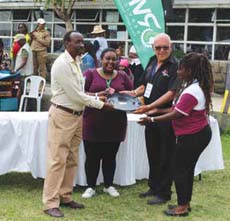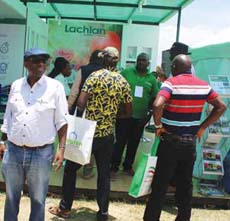 Horticultural production is concentrated in regions such as the Great Rift Valley, Lake Naivasha, Mount Kenya, and Nairobi. The total horticultural area spans approximately 496,062 hectares, yielding 7.9 million metric tonnes, with roses dominating flower exports. For more than two decades, the Naivasha Horticultural Fair has been a hub of innovation, knowledge-sharing, and business networking for those involved in the cultivation of plants, herbs, flowers, fruits, and vegetables. This annual fair has grown from modest beginnings to a grand spectacle, drawing participants from across the globe to showcase their products, exchange ideas, and explore the latest advancements in the field of horticulture.
Horticultural production is concentrated in regions such as the Great Rift Valley, Lake Naivasha, Mount Kenya, and Nairobi. The total horticultural area spans approximately 496,062 hectares, yielding 7.9 million metric tonnes, with roses dominating flower exports. For more than two decades, the Naivasha Horticultural Fair has been a hub of innovation, knowledge-sharing, and business networking for those involved in the cultivation of plants, herbs, flowers, fruits, and vegetables. This annual fair has grown from modest beginnings to a grand spectacle, drawing participants from across the globe to showcase their products, exchange ideas, and explore the latest advancements in the field of horticulture.
The concept for this event was conceived by its founder, Richard McGonnell, who aimed to not only boost Kenya’s emerging horticulture industry but also support local communities. September 22 and 23 marked the 20th edition of the fair, boasting over two hundred exhibitors and drawing a large crowd of attendees, including farmers, researchers, exporters, distributors, and curious enthusiasts - all with a shared passion for horticulture. The fair had something for everyone, from seasoned industry veterans seeking the latest breakthroughs to novice gardeners looking for tips to enhance their backyard oasis.
Visitors were greeted with colorful displays of flowers in every hue imaginable, while neatly arranged rows of fruits and vegetables beckoned with their freshness. The air was filled with the fragrant scents of blooms, creating an inviting and inspiring atmosphere.
The heart of the fair was undoubtedly the exhibition area. Spread out across a vast expanse, it was a vivid creation, brought to life through the intertwining of innovation and creativity. Here, visitors could find stalls showcasing everything from exotic flowers that seemed to have been plucked from a dream to rows of meticulously grown vegetables that celebrated the bounty of the land.
During the opening of the Fair, the Chief Guest, Agriculture CS Honorable Mithika Linturi, expressed the government’s full commitment to supporting the horticulture sector in the country. He acknowledged the delay in remittance of Value Added Tax (VAT) refunds owed to growers and assured that the issue would be resolved on a case-by-case basis as tax matters are individualized. The government owes flower growers billions in VAT tax refunds. CS Linturi assured that the Kenya Revenue Authority (KRA) would resolve the situation. He also pledged the government’s continued collaboration with agrochemical industries and regulators to ensure the safety of chemicals used in Kenyan agriculture.
 In one corner of the fairgrounds, a group of farmers huddled around a demonstration of a cutting-edge irrigation system. The presenter eloquently explained how this technology could optimize water usage and increase crop yields while conserving a precious resource. Nearby, an entomologist also engaged a captivated audience in a discussion about pest control methods, emphasizing the importance of sustainable practices in modern agriculture. Amidst the hustle and bustle, strangers became friends as they exchanged success stories as well as challenges, bonded by a shared love for nurturing life from the soil. The fair was more than just a marketplace; it was a living testament to the unity of purpose that bound these individuals together.
In one corner of the fairgrounds, a group of farmers huddled around a demonstration of a cutting-edge irrigation system. The presenter eloquently explained how this technology could optimize water usage and increase crop yields while conserving a precious resource. Nearby, an entomologist also engaged a captivated audience in a discussion about pest control methods, emphasizing the importance of sustainable practices in modern agriculture. Amidst the hustle and bustle, strangers became friends as they exchanged success stories as well as challenges, bonded by a shared love for nurturing life from the soil. The fair was more than just a marketplace; it was a living testament to the unity of purpose that bound these individuals together.
Among the visitors was Alice, a young agripreneur who had recently ventured into the world of hydroponics. Her eyes sparkled with excitement as she navigated through the stalls, taking note of the latest innovations in controlled environment agriculture. She engaged in conversations with experts who offered advice on optimizing nutrient solutions and overcoming the challenges of soilless cultivation.
On the other side of the fairgrounds, Michael, a seasoned florist, marveled at the array of exotic blooms that surrounded him. He found himself in conversation with a fellow enthusiast, a botanist who had traveled from a neighboring country to share his knowledge of rare orchid species. As they spoke, Michael’s passion for his craft was reignited, and he made mental notes of new species to introduce to his customers.
Looking ahead, Richard envisions the fair’s continuous expansion. Over the years, proceeds from the event have enabled him to establish critical facilities such as schools, healthcare centers, rehabilitation resources, and more.
As the fair came to a close on the second day, attendees departed with hearts full of inspiration and minds brimming with ideas. The Naivasha Horticultural Fair had once again proven itself as a beacon of excellence, a platform where dreams were nurtured and possibilities blossomed. Exhibitors dismantled their stalls, and the fairgrounds gradually quieted.
One couldn’t help but feel a sense of anticipation for the transformations that the knowledge exchanged here would bring to the world of horticulture in the coming year.


